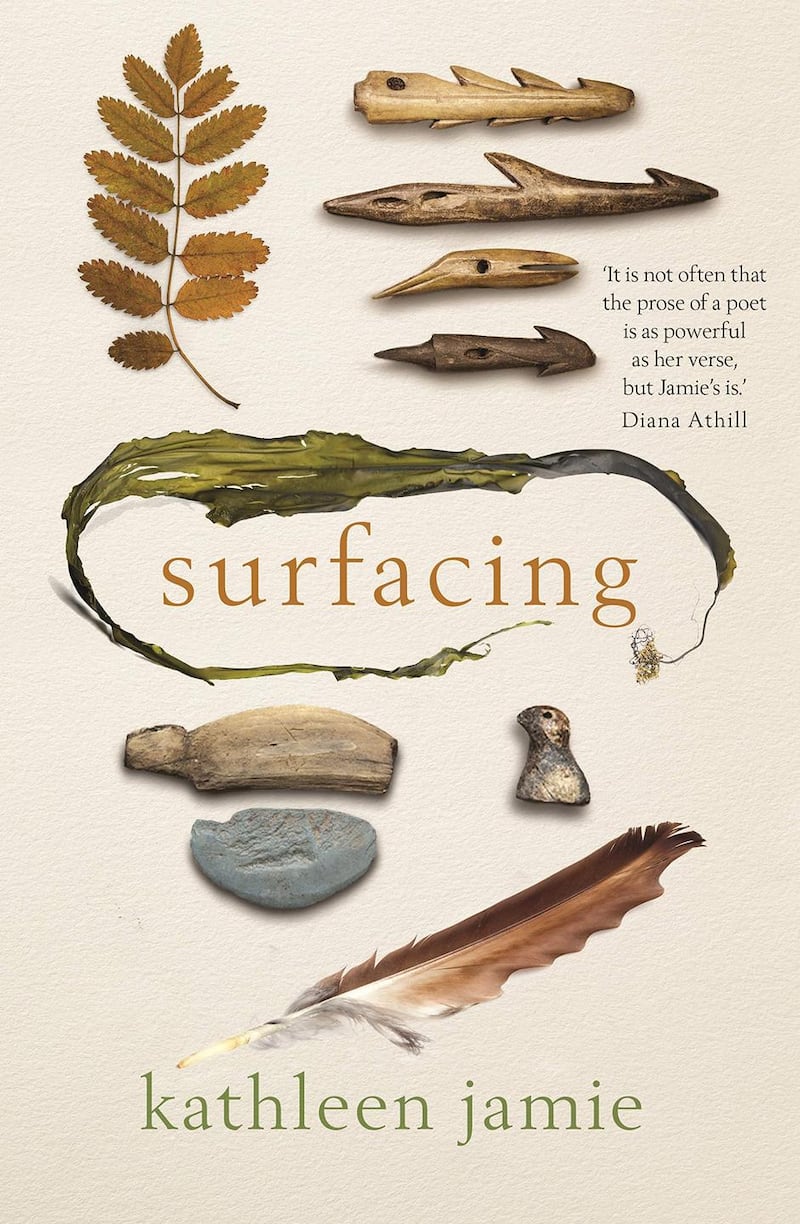“Some folks say time is a spiral, that what goes around comes around, that events remote to one another can wheel back into proximity.” This concept, from Links of Noltland III, one of a triptych of essays set on an archaeological dig in the Orkney islands, suffuses Surfacing, a beautifully produced essay collection that spirals back through interests and themes traced over the past 40 years of Jamie’s career, as well as forwards into an unknown future.
Jamie is a professor of poetry in English at the University of Stirling, and Scottish editor of Irish Pages. Her debut poetry collection, Black Spiders, won the Eric Gregory Award in 1982, and her 10 subsequent collections have been critically acclaimed, garnering awards including the Forward and Griffin Prizes. Her first work of non-fiction was a travel journal, The Golden Peak (1992), which documents a trip taken in 1989 to the autonomous region between Pakistan and India. Her first essay collection, Findings (2005), was part of the vanguard of a new and hard-to-characterise type of “landscape writing”. It was followed in 2012 by Sightlines. The particular literary niche she carved for herself was recognised in 2017, when she was awarded the Ness Prize for “outstanding creative writing at the confluence of travel, nature and culture”.
Scottish “by latitude”, Jamie resists being pigeon-holed by race, gender or politics. The search for identity informing her work is concerned with exploring the condition of earth-dweller, with all its attendant responsibilities. Unsurprisingly then, a fascination with archaeology runs through both poetry and prose, and is to the fore in this new essay collection, which looks back over a lifetime of exploration and resurfaces at the other end – older, freer and still curious.

Elsewhere Jamie has expressed distaste for the omnipresence of the author in contemporary landscape writing. Her own narrative voice is focused and restrained; she brings a sense of empathy to her topics without ever emoting, allowing the reader, like herself, to “enjoy the freedom of our own interiority”. To read a Jamie essay is to be given a fresh lens through which to view the world.
Archaeological digs
Two extended pieces in Surfacing are about archaeological digs – one in Alaska, the other in Westray, one of the Orkney islands. A sense of deep time pervades these pieces, in which material objects act as portals between epochs. “Artefacts freshly tumbled out of the earth” provide continuity. Jamie’s secular sense of transcendence is highly developed. She speaks of the 500-year-old cooking smells rising from deep excavations, of the half-lives of ghosts, of encounters with previous selves. Of particular fascination to her are amulets in animal form, or tools made from bone or hide: “I like them because they suggest a powerful relationship with the non-human world.”
The title of Surfacing refers not only to the unearthing of artefacts in digs but to a multiplicity of personal renewals: miners re-emerging from the pit, her grandmother recovering from depression, her own experience of cancer. Surfacing is also a stage of life, the rediscovery of the self in late middle-age, when parents are dead and children grown. The importance of renewal and reclamation is to the forefront, along with an anxiety about the future – on a systemic as well as an individual level. There is a strong belief in the value of continuity, constancy, craft and independence.
Emblem of humanity
Canadian poet Christian Bök has spent years working on The Xenotext, “engineering a life-form so that it becomes not only a durable archive for storing a poem but also an operant machine for writing a poem – one that can persist on the planet until the sun itself explodes.” Working with Nasa, The Xenotext was sent to Mars in 2018. The project begs comparison with Jamie’s worldview; in search of an emblem of humanity from the wealth of archaeological discoveries in Orkney, she writes:
I wondered which I would choose if God forbid I had to, to send in to outer space in hopes some other intelligence would find it, identify it, and know it as a marker and statement of our species. What would I load onto the Voyager spacecraft? … I suppose it would be one of the ugly, grunting-looking stone ploughshares, as long as my forearm an twice as thick. They spoke of hard labour, not of decoration. The breaking of the earth … Yes, I’d send that. It could hurtle through space like a meteorite, in hope that it might make landfall on some new shore.
“Was your world once wild?” A distant intelligence might ask.
Yes, we’d say. Till it went under our ploughs and the hooves of our cattle. Under the weight of our stuff.
Jamie’s interest in artefacts is mirrored by the care and attention brought to the making of this book, an elegantly typeset and tastefully illustrated hardback.













